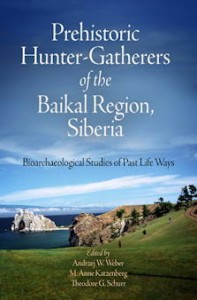Project Description
| PROJECT DESCRIPTION | FEATURED PUBLICATION |
|---|---|
|
To see our most recent project activity, please visit our new website HERE The Baikal-Hokkaido Archeology Project (BHAP), formerly known as simply the Baikal Archaeology Project (BAP) consists of an international and multi-disciplinary team of scholars with expertise in archaeology, physical anthropology, ethnography, molecular biology, geophysics, geochemistry and environmental reconstructions. Together, we are exploring prehistoric hunter-gatherer lifeways in Northeast Asia. While substantial progress has been achieved in hunter-gatherer research over the last century, it is still the case that our understanding of the dynamism, variability, and resilience of prehistoric Holocene hunter-gatherers remains rather impoverished. The goal of our project is to address this gap through an intensive comparative analysis of two long-term regional trajectories of Holocene hunter-gatherer culture change (c 10,000-present): the Lake Baikal region (Siberia) and Hokkaido Island (north Japan). Our analysis relies on what we have come to define as the bioarchaeology of individual life histories approach - a suite of methods (laboratory and macroscopic) that can generate long strings of information pertaining to the age, sex, diet, mobility, habitual activities, health and genetic traits of particular persons through examination of their skeletal remains in conjunction with their archaeological and environmental context.We previously applied this approach very successfully to the Lake Baikal region (see our previous web site) The success of our research at Baikal encouraged us to extend our application of this bioarchaeologial approach to a second and independent record of hunter-gatherer culture change; however, opportunities to apply this extremely productive approach elsewhere are limited due to the general paucity of hunter-gatherer skeletal materials. Hokkaido is a rare and promising exception, making it a ‘natural' partner region to Baikal. By introducing a comparative approach, our new research in Japan constitutes a significant and logical expansion of our previous research, which will allow us to address more general questions related to our understanding of prehistoric hunter-gatherers. In particular, our project is designed to address the following three general objectives:
|
For those more interested in learning about our research in the Lake Baikal Region of Siberia, Russia, please check out our previous web site. You might also be interested in the recently published book on the Prehistoric Hunter-Gatherers of the Baikal Region, Siberia: bioarchaeolgoical studies of past lifeways published by the University of Pennsylvania Press.
Siberia's Lake Baikal region is an archaeologically unique and emerging area of hunter-gatherer research, offering insights into the complexity, variability, and dynamics of long-term culture change. The exceptional quality of archaeological materials recovered there facilitates interdisciplinary studies whose relevance extends far beyond the region. The Baikal Archaeology Project - one of the most comprehensive studies ever conducted in the history of subarctic archaeology - is conducted by an international multidisciplinary team studying Middle Holocene (about 9,000 to 3,000 years B.P.) hunter-gatherers of the region. Funded by the Social Sciences and Humanities Research Council of Canada, the project includes scholars in archaeology, physical anthropology, ethnography, molecular biology, geophysics, geochemistry, and paleoenvironmental studies. This book presents the current team's research findings on questions about long-term patterns of hunter-gatherer adaptive strategies. Grounded in inter-disciplinary approaches to primary research questions of cultural change and continuity over 6,000 years, the project utilizes advanced research methods and integrates diverse lines of evidence in making fundamental and lasting contributions to hunter-gatherer archaeology. Andrzej Weber is Professor of Hunter-Gatherer Archaeology, University of Alberta, Edmonton. M. Anne Katzenberg, F.R.S.C., is University Professor, University of Calgary. Theodore G. Schurr is Associate Professor of Anthropology, University of Pennsylvania. Link to purchase book: http://www.upenn.edu/pennpress/book/14544.html
|
